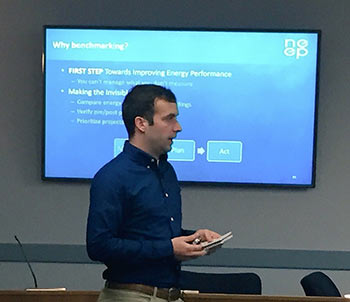By John Balfe | Mon, April 2, 18
The smell of fresh cut grass, the sounds of “take me out to the ballgame”, and the crack of a baseball bat – these are a few things that signal the beginning of baseball season.
Over the course of the six-month offseason, Major League Baseball (MLB) teams have been busy managing their rosters, improving their performance, and measuring how their squads stack up against their peers during spring training. As fans of the game, we think back to last year and how our hometown team performed. We try to recall how many homeruns, or the batting average of our favorite players (for me, that’s Mookie Betts who ended last year with 24 HRs and a .264 BA), hoping their performance will improve again this upcoming season. But ultimately, it falls on the manager to analyze the performance of each player and the team as a whole, and compare it to past seasons or opposing teams. The manager then uses this information to make changes to the team, hopefully increasing the chance of winning games.
These duties, although potentially less glamorous than winning games or championships, are not all that different from the fundamental steps needed to improve building energy consumption. Benchmarking is the process of measuring a building’s energy usage, comparing it to a previous point in time or to another similar building, with the intended goal of reducing the building’s energy usage over time. This process is typically completed by the building manager and, similar to baseball managers, it is their responsibility to examine this data and use it to make improvements to buildings.
Spring not only signals the beginning of fans filing into ballparks across the country, but it also signals the beginning of benchmarking season. Over the course of the next couple months, six municipalities in the region will receive benchmarking data from the buildings covered under benchmarking policies that have already been enacted throughout the region. These benchmarking policies range in scope but generally require municipal, commercial, and multifamily buildings of certain square footage to measure and report their energy performance to the city on an annual basis. The District of Columbia, for instance, has an April 2 deadline while the city of Cambridge, MA, has a May 1 deadline.
The newest city to step up to the plate and join the “league of benchmarking cities” is South Portland, Maine. South Portland’s benchmarking pilot program is specific to one section of the community - the Mill Creek business district which is comprised of retail shops, banks, and other commercial uses. In total, there are 30 buildings covered under the benchmarking ordinance which can be found within the city’s zoning code.
On March 6, South Portland invited building owners and managers to participate in a workshop about the new benchmarking requirement. The lineup for the workshop was as follows:
Lucy Brennan leading things off as South Portland’s Sustainability Program Coordinator. Lucy provided an overview of the South Portland benchmarking ordinance and teed up the discussion for the remainder of the day.
 Batting second, I gave a presentation on turning benchmarking data into action. The presentation provided details on how to understand using benchmarking data to hit a home run with energy efficiency improvements. This presentation supplied the scouting report on DOE’s Building Energy Asset Score which enables users to dive deep into the analytics of their building and target improvements to specific building attributes.
Batting second, I gave a presentation on turning benchmarking data into action. The presentation provided details on how to understand using benchmarking data to hit a home run with energy efficiency improvements. This presentation supplied the scouting report on DOE’s Building Energy Asset Score which enables users to dive deep into the analytics of their building and target improvements to specific building attributes.
Up next, in the most important spot of the lineup, was all-star Cyndi Veit from Environmental Protection Agency (EPA) Region One. Cyndi stepped up to the plate in a crucial situation where she was tasked with demonstrating the process of benchmarking buildings in EPA’s ENERGY STAR Portfolio Manager. Cyndi’s presentation was met with raucous applause as she fielded a number of important questions from audience members who were going to use info from the presentation to put into practice on their own.
Batting cleanup was Joe Caron from WegoWise. South Portland has teamed up with WegoWise to offer one year of free services to building owners in order to aid in the city’s benchmarking requirement and synthesizing of data for future uses.
Rounding out the lineup was Rick Meinking from Efficiency Maine. As a veteran of the energy efficiency landscape and administrator of energy efficiency programs in Maine, Efficiency Maine brings a lot to the plate. The presentation focused on encouraging building owners to take advantage of Efficiency Maine’s rebates on efficient lighting and HVAC equipment.
In South Portland, covered buildings are required to report their data to the city by May 1. The sustainability office is in midst of working with stakeholders to ensure the rookie season of the benchmarking ordinance turns into a successful and lengthy career, ultimately leading to energy efficient buildings that cost less to operate.
Whether you are a baseball manager assessing a team’s playing performance, or a building manager benchmarking a facility’s energy usage, the message remains the same: You cannot manage what you don’t measure. As more cities in the region and across the country consider the enactment of benchmarking ordinances, building managers can get ahead of the game by beginning the benchmarking process on their own. Visit EPA’s Portfolio Manager Website to get started today.
--
For more information about South Portland’s benchmarking ordinance, check out NEEP’s exemplar on the city’s efforts. To learn more about how benchmarking can help improve your building’s energy efficiency, visit NEEP.org or contact John Balfe.
